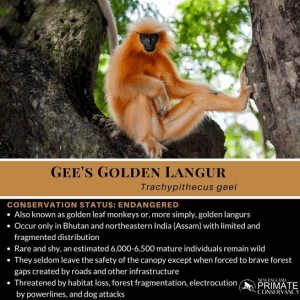TAG: GS 3: ECOLOGY AND ENVIRONMENT
THE CONTEXT: The recent comprehensive survey conducted by various institutions, including the Primate Research Centre NE India (PRCNE) and the Assam Forest Department, reveals critical insights into the population of the endangered golden langur (Trachypithecus geei) in India.
EXPLANATION:
Survey Methodology
- Two-Phased Approach
- The population estimation was executed in two phases, covering the entire distribution range of golden langurs in the Manas Biosphere Reserve and fragmented forests in the western part of Assam.
- The use of a block count method during March-April 2020 and 2021 provided data on abundance, spatial distribution, and densities of golden langur populations.
- Innovative Approach
- The survey’s application of the block count method, considered simple, cost-effective, and robust for small group-living primates, showcases innovative techniques in primate population estimation.
- Each counting block, overlaid with 50-hectare grid cells, facilitated systematic data collection.
Population Estimation Results
- Overall Population
- The survey estimates a total of 7,396 golden langurs in India.
- This includes 7,720 individuals observed, comprising 707 unique groups, 31 lone males, and floating males.
- Sub-Population Distribution
- The golden langur population is divided into two major sub-populations – a northern extended population and a southern fragmented population.
- The northern population, covering the western part of the Manas Biosphere Reserve, was estimated at 5,566 individuals, while the southern fragmented population, along the southern side of NH27, had 1,830 langurs.
- Comparisons with Previous Estimation
- Comparisons with the 2008-09 population estimation highlight an increase in the golden langur population from 6,000 to 7,396 individuals.
- However, concerns arise regarding the unstable situation in fragmented habitats.
Conservation Challenges
- Fragmented Habitat Threats
- The survey underscores challenges in fragmented habitats, particularly the absence of non-breeding all-male bands.
- This situation poses a threat to the golden langurs, emphasizing the need for conservation efforts.
- Corridor Linkage Recommendations
- Primate experts emphasize the necessity for corridor linkages among fragmented habitats through plantations and canopy bridges.
- Such measures aim to offset potential threats stemming from anthropogenic interactions.
Regional Population Distribution
- Habitat-Specific Numbers
- The survey provides a breakdown of golden langur populations in specific regions, with the Ripu Reserve Forest housing the largest northern population and Chakrashila Wildlife Sanctuary in Kokrajhar district hosting the highest number in the southern fragmented range.
Golden langur (Trachypithecus geei):
- Golden langurs are easily recognised by the colour of their fur.
- Gee’s golden langurs, also known as golden leaf monkeys, or more simply as golden langurs, live in northeastern India and southern Bhutan.
- They are confined to this geographic region by the Manas and Sankosh rivers to the east and west, the Brahmaputra river in the south, and the Black Mountains to the north.
- Here, altitudes vary greatly; golden langurs may live anywhere between sea level and 9,800 feet (3,000 m) above sea level. This is a considerable range for primates.
- This species thrives best high up in the canopies of subtropical and temperate broadleaf forests.
- However, golden langurs also make do in lowland evergreen, semi-evergreen, riparian moist deciduous forests, subalpine forests, and savannas, as well as secondary or degraded forests.
- They were considered endangered by the IUCN Red List, and listed as Appendix I on the CITES website.


